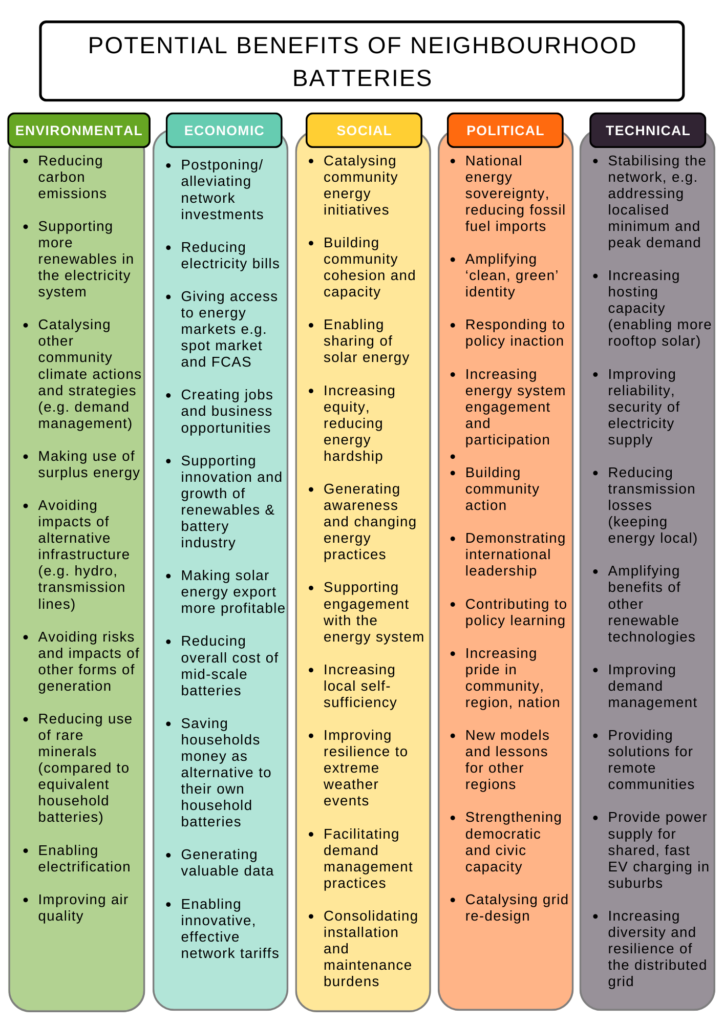Neighbourhood batteries have a range of potential benefits, for communities, the environment, and the electricity system. The core benefits that people regularly associate with neighbourhood batteries include:
- Reducing carbon emissions
- Increasing hosting capacity of the network (enabling more rooftop solar)
- Reducing energy bills
- Enabling sharing of solar energy
- Improving resilience to disasters
- Stabilising the network
- Building community action in response to climate change.
We have sought to capture the wide-ranging potential benefits in the table below.
Importantly, whether these benefits are realised in practice depends on the context, the model that’s adopted and successful implementation. They cannot all be delivered by a single battery, or even by a series of batteries. This is why getting clear about what values are most important for your project is so important. The table is intended to help projects to clarify and prioritise the values that drive their project.
Having prioritised your values, you can then develop your model to deliver those values. This will also highlight some of the trade-offs and tensions between values and may lead you to rethink your goals. For example, you need to recognise that using a neighbourhood battery to reduce carbon emissions may not be compatible with maximising revenue from the battery (see Environmental Goals & Impacts). So, you need to adjust your expectations and your business model to achieve that goal. Similarly, if your focus is on community development, you may want to focus on sharing solar energy with those that don’t have access (e.g. renters, apartment dwellers), rather than raising expectations that everyone’s energy bill will go down. Using the battery for self-sufficiency and resilience in the face of disasters may reduce the contribution it can make to other values and revenue streams.

Despite all of their potential benefits, neighbourhood batteries are relatively new and untested, so achieving benefits is not guaranteed. Thus, designing and testing a model for your particular purposes and context is critical. You should also take the time to consider alternatives (see Alternatives) and whether they may better, and more easily, meet your needs.
Benefits associated with building community, contributing to climate action, awareness and shifts in energy practices (e.g. reducing energy use or shifting time of use) and community engagement in energy transition can all spring from non-financial involvement with the battery. If community members are given information about the battery and its services, they can develop a sense that it’s ‘their battery’, even if they’re not formally signed up in any sense. This will be strengthened if opportunities have been provided for people to have a say about design and operation. Efforts can be made to recognise the battery as a piece of cultural infrastructure, a visible symbol of the community’s commitment to climate action and energy sharing. This could involve, for example, making the battery a piece of community art as done by YEF with the North Fitzroy battery. Crucial to building a community’s connection to the battery is transparency about what services the battery is providing and accountability around the benefits.
Trials and implementation of neighbourhood batteries across the country will shed light on what neighbourhood batteries can deliver for whom and which models best deliver what benefits. It is important to keep in mind that neighbourhood batteries are part of the electricity system, so governed by the National Electricity Rules (see Regulatory considerations). As public infrastructure, they also need to deliver public good and meet public expectations. This is important for ongoing support of neighbourhood batteries.
